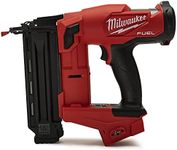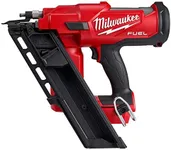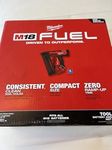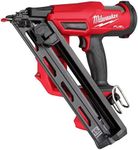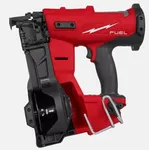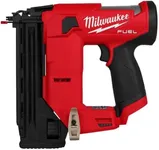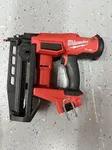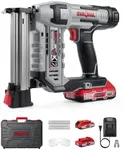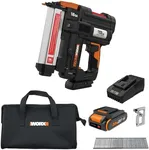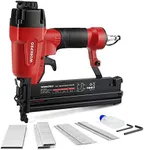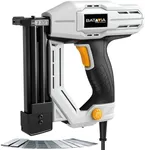Buying Guide for the Best Milwaukee Cordless Nail Guns
When it comes to choosing a Milwaukee cordless nail gun, it's important to consider several key specifications to ensure you get the best tool for your needs. Cordless nail guns offer the convenience of mobility without the hassle of cords or hoses, making them ideal for various construction and DIY projects. To make an informed decision, you should understand the different specs and how they relate to your specific requirements.Nail GaugeThe nail gauge refers to the thickness of the nails that the gun can handle. This is important because different projects require different nail sizes. Nail gauges typically range from 15 to 23, with lower numbers indicating thicker nails. For heavy-duty tasks like framing or decking, a lower gauge (15-16) is suitable. For finish work or delicate trim, a higher gauge (18-23) is better. Choose a nail gauge based on the type of work you plan to do most often.
Nail LengthNail length is the maximum length of nails that the gun can drive. This is crucial for ensuring that the nails are long enough to securely fasten materials together. Nail lengths can vary from 1 inch to 3.5 inches or more. For general construction, longer nails (2.5-3.5 inches) are often needed, while shorter nails (1-2 inches) are typically used for trim and finish work. Consider the materials and the depth of penetration required for your projects when selecting nail length.
Battery LifeBattery life determines how long the nail gun can operate on a single charge. This is important for productivity, especially on larger projects. Battery life can vary based on the voltage and capacity of the battery. Higher voltage batteries (18V or more) generally offer longer run times. If you plan to use the nail gun for extended periods, look for models with longer battery life or consider having spare batteries on hand. Match the battery life to the scale and duration of your typical projects.
Firing ModesFiring modes refer to the different ways the nail gun can drive nails. Common modes include sequential firing, where each nail is fired with a trigger pull, and bump firing, where nails are fired rapidly by bumping the gun against the work surface. Sequential firing offers more precision and control, making it ideal for detailed work. Bump firing is faster and better for high-volume tasks. Choose a nail gun with the firing mode that best suits your working style and project needs.
Weight and ErgonomicsThe weight and ergonomics of the nail gun affect how comfortable it is to use, especially over long periods. Lighter models are easier to handle and reduce fatigue, which is important for extended use. Ergonomic designs with comfortable grips and balanced weight distribution can also enhance usability. If you plan to use the nail gun frequently or for long durations, prioritize models that are lightweight and ergonomically designed to minimize strain and improve efficiency.
Depth AdjustmentDepth adjustment allows you to control how deep the nails are driven into the material. This is important for achieving a professional finish and ensuring that nails are flush with or slightly below the surface. Depth adjustment can be manual or tool-free, with tool-free adjustments being more convenient. For projects requiring precise nail placement, such as finish carpentry, having easy and accurate depth adjustment is essential. Choose a nail gun with a depth adjustment feature that matches the precision needed for your work.
